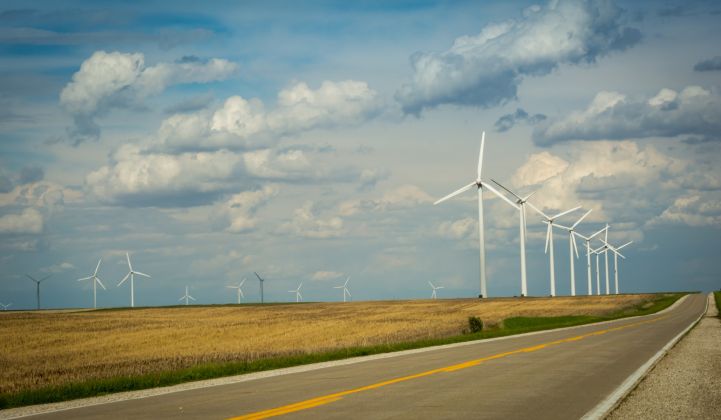The Midwest has long been a wind energy hub. Now, an increasing number of the region’s utilities are turning away from baseload coal and contemplating a future that relies heavily on clean energy.
Utilities in states such as Iowa, Kansas, Wisconsin and Michigan have recently announced goals to pivot toward cleaner resources.
In Kansas, newly joined Westar Energy and Great Plains Energy (also known as Kansas City Power & Light) — now collectively known as Evergy — laid out a plan to retire a handful of old coal plants this fall and begin cleanup of the leftover coal ash.
An executive of the company, John Bridson, told the area’s NPR affiliate that “it’s time to retire older, less-efficient fossil fuel plants.”
Kansas has a renewable portfolio standard of 20 percent by 2020, and Missouri, where the two utilities also serve customers, requires 15 percent by 2021. To meet the goals, Evergy is investing in projects like a July deal to purchase power from a 300-megawatt wind farm in northeastern Kansas. Evergy projected its renewables portfolio will reach 3,500 megawatts by mid-2019. Its current combined portfolio is 13,083 megawatts.
Wisconsin’s two largest public utilities, Alliant Energy and WEC Energy Group, also announced new emissions reductions goals this month. The two upgraded previous commitments of 40 percent below 2005 levels by 2030 to 80 percent below 2005 levels by mid-century.
They’ll meet the goal by relying less on coal and moving toward more clean energy and natural gas. The state has a 10 percent by 2015 renewable portfolio standard, which it met but has not updated.
In its latest annual report, Alliant (which also services parts of Iowa) said nearly a third of its generation will come from renewable sources in 2024. Through 2020, the utility said it will invest $2 billion in wind. At the same time, Alliant is shifting its baseload generation away from coal and toward gas: 40 percent of its 2010 coal-fired capacity was retired or transitioned to gas by the end of last year.
Between 2005 and 2017, WEC Energy’s renewable generation has inched up from 2.5 percent to 5.1 percent, not including nuclear power. During that same time, its natural gas generation grew from 6 percent to 19.7 percent, and the utility moved from 62.6 percent coal generation to 48.7 percent.
Though utilities have pledged a commitment to renewables, the continued reliance on fossil fuel sources has rankled environmentalists.
“It’s very underwhelming,” Wisconsin Sierra Club campaign representative Elizabeth Katt Reinders told the Milwaukee Journal Sentinel of Alliant and WEC’s goals. “We need to move off coal completely — and sooner.”
Environmentalists in Iowa are also pushing back against goals set by MidAmerican Energy to achieve 100 percent renewable energy by 2020. Josh Mandelbaum, a senior attorney at the Environmental Law & Policy Center, called the target “a bit of a gimmick” because the utility is still reliant on coal.
Though the utility has announced $12 billion in wind investments, the Environmental Law & Policy Center claims that MidAmerican’s coal-fired generation puts it in the top 20 largest utility coal fleets in the U.S. In 2017, MidAmerican’s 9,794 megawatts of generation capacity included 49 percent wind and 30 percent coal across Iowa, Illinois, South Dakota and Nebraska.
Similar transition pains have been made by DTE Energy in Michigan. While Crain’s Detroit Business reports that the utility has suggested it would excise coal from its portfolio by 2040, that source currently makes up nearly 65 percent of its generation. Wind accounts for just 6.75 percent and solar for just 0.18 percent of its portfolio. The utility said it will add 4,000 megawatts of renewables by 2040.
“Time will tell exactly how it will happen," Irene Dimitry, DTE's vice president of business planning and development, told Crain’s.
Its peer, Consumers Energy, has committed to no coal by 2040, but its road is shorter; the utility reported its generation portfolio in 2017 included only 23 percent coal. Consumers' latest integrated resource plan suggests much of that demand will be met with renewable energy, which now accounts for only 5 percent of generation. Natural gas was Consumers’ largest source of generation in 2017, at 40 percent.
In 2016, Consumers' parent company CMS Energy retired seven coal-fired plants, 33 percent of its coal-generated capacity. Consumers also has a goal to reduce pounds of carbon dioxide emissions produced per megawatt-hour to 20 percent by 2025 from 2008 levels.
Aside from commitments — whether hollow or not — it’s notable that much of the push toward renewables has come in the absence of federal policy leadership. Both Wisconsin utilities, for instance, plan to beat out the 32 percent emissions cuts set out in President Obama’s Clean Power Plan, even as that initiative remains caught in legal limbo.




